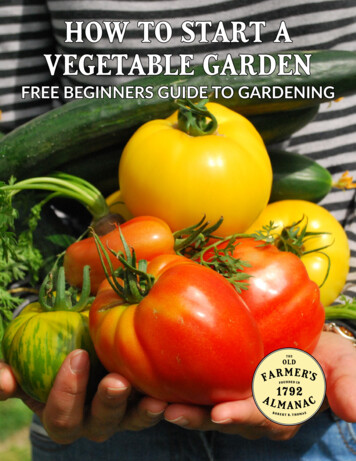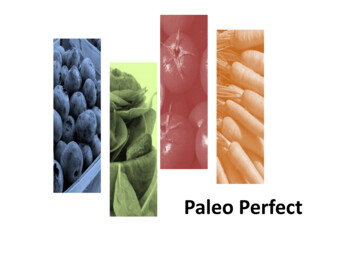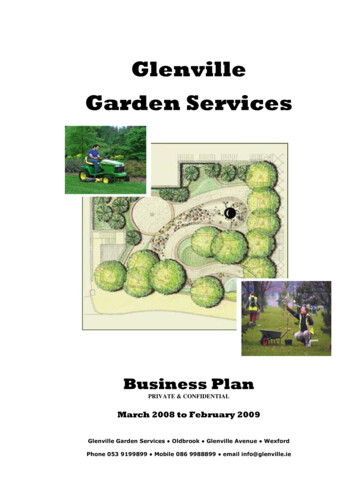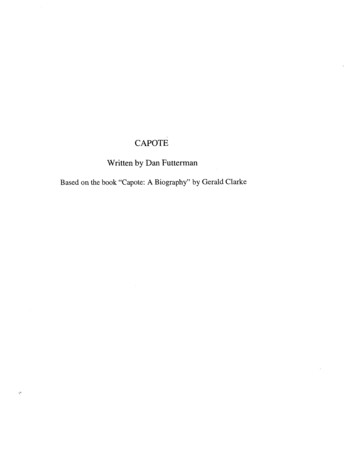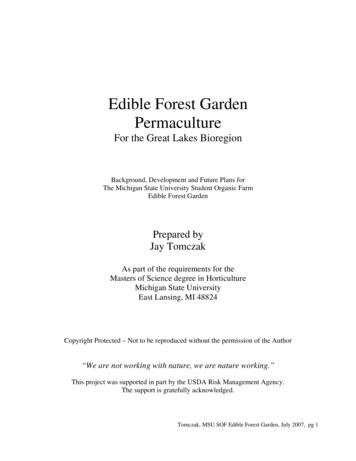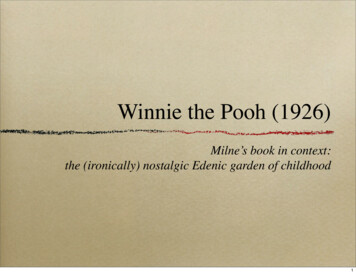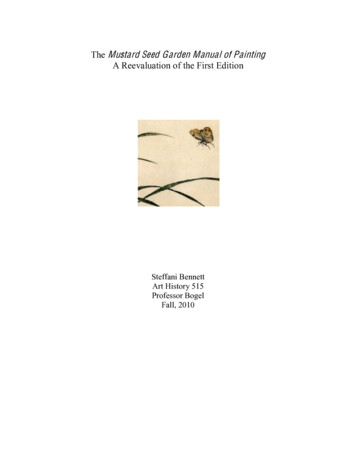
Transcription
The Mustard Seed Garden Manual of PaintingA Reevaluation of the First EditionSteffani BennettArt History 515Professor BogelFall, 2010
1The Mustard Seed Garden Manual of PaintingA Reevaluation of the First Edition³ OO P\ OLIH , KDYH ORYHG ODQGVFDSH SDLQWLQJ EXW LW KDV EHHQ WKH SOHDVXUH RI ORRNLQJ DW RWKHU SHRSOH¶V ZRUN IRU , P\VHOI FDQQRW SDLQW 1Thus wrote Li Yu, the Qing dramatist and playwright, who composed theintroduction to part I of the Mustard Seed Garden Manual of Painting (henceforthMustard Seed Manual) published in 1679.2 Issued in twenty editions, this work isrecognized by many scholars as &KLQD¶V preeminent painting handbook.3 This notionmight initially lead one to assume that the manual was widely read by and circulatedamong the Chinese public in varying levels of early Qing society. However, a closerexamination of the aesthetic qualities of extant prints from the first edition of the MustardSeed Manual, the nature of commercial book publications in the Qing, and the socialenvironment of this period prompts one to ask who was the primary audience for the firstedition of the Mustard Seed Manual ? What significance did the manual have for itsowners and readers in the early years of its publication?4The Mustard Seed Manual was first published in late winter of the eighteenth yearoI WKH (PSHURU .DQJ[L¶V UHLJQ. The story, however, begins earlier that winter of 1679when Li Yu, a playwright and essayist, received a manuscript from Shen Shin\X /L¶V son-in-law and the manager of the Mustard Seed Garden Publishing House. Thepublishing house and the manual, itself, both drew WKHLU QDPHV IURP /L X¶V JDUGHQ DQG house located on a hillock near the South Gate in Nanjing. Shen Shinyu hadcommissioned the manuscript from the local landscape painter, Wang Gai, more than1Wang Kai, The Mustard Seed Garden Manual of Painting , trans. Mai-mai Sze (Princeton: PrincetonUniversity Press, 1992), 11.2Chun-shu Chang and Shelley Hsueh-lun Chang, Crisis and Transformation in Seventeenth Century China:6RFLHW\ &XOWXUH DQG 0RGHUQLW\ LQ /L X¶V :RUOG (Ann Arbor: University of Michigan Press, 1992), 95. In theirbiographical study of Li Yu, Chun-shu Chang and Shelley Hsueh-lun Chang note that the manual was actuallypublished at the end of the Chinese lunar year in the eighteenth year of the Emperor KDQJ[L¶V UHLJQ ZKLFK FRUUespondsto late January of 1680 according to Western calculation.37KH RQO\ VRXUFH , KDYH IRXQG WKDW SURYLGHV FRQFUHWH HYLGHQFH IRU WKLV DVVHUWLRQ LV .¶DL-PLQJ &K¶LX¶V DUWLFOH The Chieh Tzu Yuan Hua Chuan (Mustard Seed Garden Painting Manual): Early Editions in American Collections6HH ELEOLRJUDSK\ &K¶LX &K¶LX FLWHV WKH UHIHUHQFHV PDGH WR WKH PDQXDO LQ RIILFLDO ELEOLRJUDSKLHV VXFK DV WKH Ching Shi Gao ( Draft Dynastic History of the Qing Dynasty, 1644-1911) and the Huang Chao Xu Wen Xian Tong Kao(A General Survey of the Institutional and Cultural History of the E mpire, 1786-1911), as well as a reference in theprivate bibliography of the scholar-painter Yu Shaosong (b.1885) entitled Shu Hua Shu Lu Jie Ti (A CriticallyAnnotated Bibliography of Chinese Calligraphy and Painting ).4For the purpose of this study I have defined the first edition as the printings issued in 1679 and 1701, whichtogether constitute the first complete edition.
2three years earlier, based on a draft by the poet-painter Li Liufang (1575-1629).5 WangGai was the only pupil of the renowned Ming-Qing transition painter Gongxian (16191689). Although he not is included among the eight masters of Nanjing, Wang Gai wasassociated with this painting circle.6Thus, Wang Gai became the compiler and author of the first edition. The firstpublication, part I of the manual, consisted of five volumes on the theme of landscapepainting. The original dimensions of the books were seventeen centimeters in width bytwenty-seven centimeters in length. Wang dedicated the first volume to the variousprinciples of Chinese painting. The following three volumes included the Book of Trees,the Book of Rocks and the Book of Renwu (³3HRSOH DQG 7KLQJV ). The final volume was acompendium of landscapes modeled on the paintings of contemporary and historicalmasters. In 1701 Wang Gai was assisted by his brothers, Wang Nie and Wang Shi, in thecompilation of parts II and III.7 Part II included the Book of the Orchid, the Book of theBamboo, the Book of the Plum, and the Book of the Chrysanthemum, collectively knownDV WKH ³)RXU *HQWOHPDQ Part III followed with the Book of Grasses, Insects andF lowering Plants and the Book of Feathers-and-Fur and F lowering Plants.8 Together,the five volumes of 1679 and the six volumes of 1701 were the first complete edition.Though Li Yu, the original publisher of the manual, was delighted by the outcomeof the 1679 publication and expressed interest in an expanded version, he died before thesecond printing in 1701. The 1679 printing was, however, /L X¶V greatest publicationsuccess, and would have indeed left him gratified at the results of the expense and efforthe had devoted to this commercial venture.9 In 1782 the entire manual was reprinted withnewly cut blocks in a second edition; in 1800 a third edition was printed. Another editionwas published in 1887-88 using the new lithographic process, but the product of thelithographic printing was far inferior in quality to that of the woodblocks. The twentieth-5Chang, 95.Sally W. Goodfellow, ed., Eight Dynasties of Chinese Painting: The Collection of the NelsonGallery-Atkins Museum, Kansas City, and the Cleveland Museum of Art (Cleveland: Cleveland Museum of Art incooperation with the Indiana University Press, 1980), 295.7Wang Shi and Wang Nie were also assisted by the painters Wang Zhi and Zhu Sheng.8A spurious part V, a volume of human figures, appeared in 1818, but it was XQUHODWHG WR WKH PDQXDO¶V original authors and publishers.9Chang, 95.6
3century saw numerous re-SULQWLQJV QRQH RI ZKLFK DFFRUGLQJ WR WKH VFKRODU .¶DL-ming&K¶LX FDQ EH ³FRPSDUHG LQ TXDOLW\ ZLWK WKH ILUVW WKUHH HGLWLRQV 10Visual analysis of extant prints from the first edition of the Mustard Seed Manualdemonstrate the luxury-commodity nature of these publications. The preserved firsteditions consist of several hundred pages, and are housed at various Americaninstitutions.11 The British Museum also owns twenty-two first edition prints. The imagesused in this study were drawn from the British Museum Collection, as the author haspersonally seen examples from this group.A beautifully preserved leaf from this collection is entitled Iris and Rock frompart III of the 1701 edition (Fig. 1). The illustration is of a single iris flower and budnestled against a water-worn rock. A few yellow wildflowers peer demurely around andWKURXJK WKH URFN¶V LUUHJXODU VXUIDFH 7KH UHJLVtration of the image is precise.12 The linesthat delineate the petals and stems are delicate and un-modulated. The block-cutterlabored over the multitude of striations in the elegant, elongated leaves and on the fragilesurfaces of the iris petals. The rock formation exhibits a dynamic, expressive contourline, in addition to stippling and areas of shading that create a distinctly rough texture.The coloring of the print is as sophisticated as the cutting of the block. TheIUHVKQHVV RI WKH SULQW¶V YDULRXV SLJPHQWV HYHQ DIWHU WKUHH KXQGUHG \HDUV RI H[SRVXUH LV D testament to their original beauty. The nuanced shades of yellow, green and blue areexquisite in their tonal delicacy. The colorist of this print employed an innovative colorgradation technique, first used in the 1633 publication of the renowned Ten BambooStudio Collection of Calligraphy and Painting (henceforth Ten Ba mboo Studio). Thistechnique of hand-wiping color across the block was skillfully executed on the iris petalsof the British Museum print. The result is a gradual lightening of color that proceeds fromthe inner part of the petal to its outer edge. The bottom of the petal appears to reproducethis coloration in reverse. The print is further punctuated with a red seal in the upper left-10&K¶iu, 60.Wang and Sze, xi. The following American institutions own prints from the first edition: 1679 (part I):Nelson Gallery of Art and Atkins Museum, Harvard-Yenching Institute, Rhode Island School of Design; 1701 (part II):Nelson Gallery of Art and Atkins Museum, Columbia University; 1701 (part III): Nelson Gallery of Art and AtkinsMuseum.12One may note that the registration of the green and yellow blocks used for the small wildflowers wasslightly less accurate.11
4hand portion of the print, preceded by a two-line inscription rendered in elegant semicursive script.The leaf entitled Lotus F lower, also from part III of the 1701 edition, is yetDQRWKHU H[DPSOH RI WKH DUWLVWLF YDOXH RI WKH PDQXDO¶V LOOXVWUDWLRQV (Fig. 2). In this image afully blossoming lotus and a semi-opened flower sway in a gentle breeze. The registrationof these blocks was even more skillfully executed than that of the Iris and Rock. Onceagain, the attenuation and thread-like tension of the contour lines, especially those of thepetals, speaks to a superior level of craftsmanship. The reeds behind the lotus flowerstwist and bend in the pictorial space. The simple color palette is highly effective inVXJJHVWLQJ WKH IORZHUV¶ SDVVLQJ EHDXW\ LQGLFDWHG E\ WRXFKHV RI \HOORZ DQG EURZQ RQ WKH tips of the petals and on the worm-eaten leaf. The calligraphy of the inscription, thoughrendered in a different style from that of the previous image, is no less sophisticated in itsexecution.The graceful rendering of these images in wood, in a range of exquisite colors,provides sufficient reason to believe that the Mustard Seed Manual was a costlypublication. The first edition exhibits the use of up to five colors, a technique that wasused in very few publications at this time.13 In his preface to the first complete edition of1701, Wang GDL LQ IDFW ZURWH ³0U 6KHQ [Shen Shinyu] has a deep interest incalligraphy and painting and has spared no expense in commissioning the finestFUDIWVPHQ WR ZRUN RQ WKH ZRRGEORFN UHSURGXFWLRQV RI WKH H[DPSOHV 14There is a paucity of information regarding the publishing details of the manual¶V first edition, however. How many printings were taken from the first blocks? How manypublications were sold? For how much did these editions sell? A definite answer to thesequestions would require access to resources that are beyond the scope of research for thisstudy. A comparison with The Ten Bamboo Studio, and with the commercial publictionsof Sibao, in Fujian Province, however, might shed light on how the first edition of theMustard Seed Manual can be considered a luxury commodity that catered to an eliteaudience.1972), 2.13Wang Gai, Xun Chao, Peiheng Hu, and Feian Yu, Jie Zi Yuan Hua Zhuan (Jiulong: Zhonghua ShuJu,14Wang and Sze, 318.
5The Ten Bamboo Studio first appeared in Nanjing in 1643. In a preface to a lateredition of this work, dated 1715, the publisher, Hu ZhengyaQ ZURWH ³:H KDYH VSHQW large sums of money and have not spared our efforts. 15 This remark suggests thesignificant investment, both human and monetary that Hu devoted to this publication. Inscope, the Ten Bamboo Studio had some 180 illustrations, and only employed two tothree color blocks (Fig. 3). In comparison, the first edition of the Mustard Seed Manualcontained 202 colored illustrations, 126 of which were double page illustrations utilizingup to five colors. This relative comparison certainly indicates the financial investmentinvolved in publishing a work like the Mustard Seed Manual , albeit nearly forty yearsafter the Ten Ba mboo Studio.At the time of the 7HQ %DPERR 6WXGLR¶V publication, it was cities like Nanjingthat began to dominate higher-end production of woodblock printed books.16 However, anumber of the major publishing centers of the late Ming, such as Hangzhou and Nanjing,suffered economically during the dynastic transition. In Nanjing the number of publishinghouses in the early Qing numbered only seven, compared to thirty-eight in the lateMing.17 This is precisely the era in which the Mustard Seed Manual was published. Thedrastically reduced number of publishing houses in Nanjing in the early years of the Qingperhaps suggests that the publications of these houses, especially luxury works like artalbums, could command even higher prices on the market than they had in the Ming.The first indicator of the 0XVWDUG 6HHG 0DQXDO¶V relative quality lies in the coststhat were necessarily involved in cutting and printing the blocks. The cutting of theblocks, in fact, accounted for the greatest production expense. The highly skilled andliterate carvers of Huizhou, including the Huang, Wang, Qiu and Liu family lineages,represent the high-level of refinement that was possible in the block-cutting craft.Because of their skill such carvers commanded significantly higher wages than those ofuntrained laborers.18 On the other hand, religious devotees, women, and peasants wereoften hired to carve blocks for lower-quality publications for negligible pay. Even the15Joseph Vedlich, The Ten Ba mboo Studio: A Chinese Masterpiece (New York: CrescentBooks, 1979), 10.16Lucille Chia and W.L. Idema, Books in Numbers: Seventy-fifth Anniversary of theHarvard-Yenching Library: Conference Papers (Cambridge: Harvard-Yenching Library, 2007), 147.17Cynthia J. Brokaw, Commerce in Culture: the Sibao Book Trade in the Qing and Republican Periods(Cambridge: Harvard University Asia Center, 2007), 10.18Brokaw, Commerce in Culture, 15.
6most cursory examination of the 0XVWDUG 6HHG 0DQXDO¶V extant prints, however,demonstrates that the block cutters of this publication were more than competent in theircraft and engaged in the task with great aesthetic sensitivity. The fluidity and delicacy ofthe lines and attention devoted to pictorial detail that characterize these images are visualproof of the expertise of the craftsmen whom Shen Shinyu employed for this project.A more concrete idea of the cost of a work like the Mustard Seed Manual may beJOHDQHG IURP &\QWKLD - %URNDZ¶V FRPSUHKHQVLYH VWXG\ RI WKH FRPPHUFLDO SXEOLVKLQJ houses of Sibao, a small, rural town in western Fujian Province, during the Qing. Thecharacteristic feature of the Sibao publishers was the profusion of their cheap, lowquality publications. Brokaw asserts that WKHVH ZRUNV ZHUH SULPDULO\ ³WH[WV RI DVVXUHG popularity rather than interestingly esoteric works of scholarship or literature 19 Thisincluded popular titles such as the Sanzi Jing (Three-Character Classic) and the ShujingLiju ( Classic of History). In her analysis of publication wholesale prices of certain Sibaoimprints in the late Qing, Brokaw determined that over half of the titles listed in the saleaccount sold for less than 1.0 qian.20Among the more expensive Sibao printings were works like the Kangxi Zidian ata wholesale price of 8.3 qian. V %URNDZ QRWHV KRZHYHU QHLWKHU ³JUHDW VNLOO RU OLWHUDF\ were prerequisites for the carving of these kinds of publications, and thus the publicationcosts of such works were comparatively low.21 However, even these publications werebeyond the means of most people. In 1884, some teachers may have earned as much as48 liang (one liang equals ten qian), but many earned as little as eighteen liang, per year.Clearly for many, it was only possible to buy the cheapest Sibao imprints (i.e. under 1.0qian).22Although these figures were calculated for the late Qing period and may not seemapplicable to the price of publications in the late seventeenth and early eighteenthcenturies when the Mustard Seed Manual was first issued, it is significant that during theQing the cost of printed books decreased beginning in the Jiaqing era (1796-1820).23 This19Brokaw, Commerce in Culture, 6.Ibid., 514.21Ibid., 14.22Cited in Brokaw, Commerce in Culture, 515, from Evelyn Rawski, Education and Popular Literacy in&K¶LQJ &KLQD (Ann Arbor: University of Michigan Press, 1979), 56-61.23Brokaw, Commerce in Culture, 517.20
7indicates that estimates for sale prices during the early Qing would likely be even higherthan the figures quoted here. Publications, even of basic texts, would have beenprohibitively expensive for a significant segment of the non-elite population. In his articleon niche marketing in late imperial China, the scholar Robert E. Hegel also notes thatbook producers in the Qing targeted higher and lower income audiences. In catering toWKHVH JURXSV FRPPHUFLDO SXEOLVKHUV GLVFULPLQDWHG DJDLQVW ³JHQHUDO buyers, with fewermiddling-quality imprints for the sheng-yuan, or the middle-OHYHO ERRN EX\LQJ SXEOLF 24Furthermore, DOWKRXJK VRPH RI WKH 6LEDR ZRUNV OLVWHG LQ %URNDZ¶V DQDO\VLV PD\ have included rather crude illustrations, it is doubtful that even the most expensive of theSibao imprints were multi-colored. It becomes readily apparent, then, that a volumeconsisting of over two-hundred beautifully colored images would have been well beyondthe purchase potential of people at the middle or lower levels of society. One scholar,Chang Chung-li, has proposed WKDW GXULQJ WKH 4LQJ ³WKH JHQWU\ FODVV HQMR\HG D SHU FDSLWD income about sixteen times that of commoners thus placing expensive, high qualitypublications much more easily within their reach.25 Did Li X¶V Mustard Seed GardenPublishing House produce these kinds of publications?Although there is a scarcity of information regarding the Mustard Seed GardenPublishing HRXVH /L X¶V ELRJUDSK\ does provide some clues as to the nature of thisbusiness venture. In 1657, after having established his career as a professional writer inHangzhou, Li Yu settled in Nanjing. His financial anxiety over an outstanding debt waswhat perhaps prompted him to begin publishing books and to open a bookstore. Althoughthe biographical information is vague, it seems likely that Li Yu published his ownliterary works through his publishing house, especially considering the difficulty he facedwith publishers in Hangzhou who frequently issued pirated copies of his works.26By the time he settled in Nanjing, Li Yu was already well received as aplaywright and essayist in literary circles, and his group of friends and acquaintancesincluded other distinguished writers, intellectuals, and high government officials.27 It is245REHUW ( HJHO ³1LFKH 0DUNHWLQJ IRU /DWH ,PSHULDO )LFWLRQ LQ Printing and Book Culture in LateImperial China , ed. Cynthia J. Brokaw and Kai-wing Chow (Berkeley: University of California Press, 2005), 253.25Richard J. Smith, &KLQD¶V &XOWXUDO HULWDJH 7KH &K¶LQJ '\QDVW\ -1912 (Boulder: Westview Press,Inc., 1983), 57.26Chang, 71.27Ibid., 77.
8reasonable to surmise that this group of elites patronized his bookstore and supported hispublishing house. By 1669, the year in which he built the famed garden and house, thebiographical record states the specific existence of the Mustard Seed Garden PublishingHouse. Of the publishing house, the author says, it was ³YHU\ VXFFHVVIXO HYHQ WRGD\ books published by the Mustard Seed Garden are prized by bibliophiles 28The publishing house provided Li with a supplementary hobby and an importantsource of income to maintain his extravagant life-style, but it was not his main devotion;that he gave to the theater and to drama. Management of the business fell to his eldestGDXJKWHU¶V KXVEDQG Shen Shinyu. When Li returned to Hangzhou, after twenty years ofUHVLGHQFH LQ 1DQMLQJ KH ZDV IRUFHG WR VHOO KLV ERRNVWRUH DQG KLV SXEOLVKLQJ ILUP¶V ³YDOXDEOH ZRRG EORFNV ZKLFK KH ZDV IRUWXQDWHO\ DEOH WR EX\ EDFN VKRUWO\ DIWHU KLV move.29 Not until the winter of 1679 did Shen present his father-in-law with themanuscript for the Mustard Seed Manual . It is not clear whether the firm remained inNanjing or relocated with Li to Hangzhou, but the printing of the Mustard Seed Manualproved to be the PRVW VXFFHVVIXO RI DOO /L¶V SXEOLVKLQJ YHQWXUHV Based on this information, LW VHHPV WKDW /L¶V SXEOLVKLQJ ILUP ZDV UDWKHU VPDOO certainly smaller in scale than a large commercial publishing house, but was quitelucrative, perhaps due to the relatively high prices for which his publications sold. ShenShinyu employed fairly well known artists to design the illustrations. Although specificinformation regarding the block cutters and colorists LV ODFNLQJ /L¶V EORFNV ZHUH valuable, and thus they were presumably of high quality. Furthermore, visual analysis ofWKH PDQXDO¶V SULQWV and Wang GDL¶V RZQ WHVWDPHQW LQ WKH SUHIDFH FOHDUO\ demonstrate that the block cutters and colorists were highly skilled craftsmen. The factthat Mustard Seed Garden publications are treasured by collectors today provides furtherevidence in support of the high quality and luxury status of works like the Mustard SeedManual.In an attempt to clarify the significance of a work like the Mustard Seed Manual ,and for whom the first editions were intended, it is necessary to examine the urban socialenvironment of the early Qing. Urban centers flourished in this period, particularly the2829Chang, 81.Ibid., 93
9cities of the Jiangnan, including Nanjing, Hangzhou and Suzhou. Nanjing, the home of Li X¶V 0XVWDUG Seed Garden Publishing House, was somewhat surpassed by Yangzhou,and even Beijing, in terms of cultural preeminence after the Ming-Qing transition.However, it maintained its identity as an important commercial city and as a center ofcultural activities carried out by a population of educated elites and wealthy merchants.30A defining characteristic of this urban milieu was the blurring of traditional socialboundaries and a gradual merging of certain social classes. This trend manifested itself ina number of ways. The effects of a burgeoning population and of Manchu rule meant thata number of degree-holding literati were unable, or unwilling, to pursue careers ingovernment and turned instead to commercial endeavors or careers as professionalpainters. At the same time, professional painters, traditionally relegated to the low rungsof society, came to enjoy economic success and move among the elite.31Merchants, also, by virtue of their wealth, could increasingly participate incultural activities that had hither-to been the exclusive prerogatives of degree-holdingelite. This included such activities as participation in literary societies, patronage of thearts and consumption of luxury products. As the scholar Mark Elvin has remarked of6KDQJKDL¶V VRFLDO HQYLURQPHQW LQ WKH 4LQJ ³WKH PRUH LPSRUWDQW PHUFKDQWV DQG JHQWU\ RI Shanghai had become, to a substantial extent, members of the same class. 32 This socialmobility inevitably gave rise to certain tensions, particularly among the literati whosought to safeguard their privileged social status, yet it also created a distinctive urbanFXOWXUH ³VKDUHG E\ XUEDQ UHVLGHQWV Zho came not only from different social strata, butalso from major cities throughout the empire 337KRXJK VRFLHW\¶V ³HOLWH FODVV ZDV UDSLGO\ EHLQJ UHGHILQHG WR LQFRUSRUDWH ambitious merchants and artisans, the literati still commanded authority in the realm ofculture and aesthetic taste. This circumstance led to the emergence of a luxurycommodity market, by which the socially ambitious could emulate and perhaps even gainentrance into the literati life-style. The scholar, Jonathan Hay, has termed this the30Susan Naquin and Evelyn S. Rawski, Chinese Society in the Eighteenth Century (NewHaven: Yale University Press, 1987), 56.31Jonathan Hay, Shitao: Painting and Modernity in Early Qing China (Cambridge:Cambridge University Press, 2001), 20.32Cited in Smith, 60, from William G. Skinner, ed., The City in Late Imperial China (Stanford: StanfordUniversity Press, 1977), 468.33Naquin, 56.
10³commodification RI OLWHUDWL FXOWXUH D SKHQRPHQD WKDW GHYHOoped within the frameworkof an expanding luxury market.34 6RFLHW\¶V HOLWH FODVV HQJDJHG LQ WKH FRQVXPSWLRQ RI such luxury items as paintings, calligraphy and books. As Frederic Wakeman has writtenRI XUEDQ PHUFKDQWV ³(PXODWLQJ WKH JHQWU\¶V VWDWXV PDQQHU RQ D FRORVVDO VFDOH WKH\ consumed their capital conspicuously«UHDIILUPLQJ WKH KHJHPRQ\ RI WKH OLWHUDWL¶V KLJK culture 35 Among the most notable imitators of literati life-style were the pioneeringHuizhou merchants who constituted the eighteenth-FHQWXU\¶V PRVW DUGHQW ERok collectors.Art collections and paintings ZHUH DOVR WDQJLEOH HPERGLPHQWV RI FXOWXUH LQ ³KLJK GHPDQG among men of wealthy and uncertain status 36Perhaps, for the wealthy merchants and literati who owned the Mustard SeedManual, such a work was not only a signifier of social status and taste, but also a tool ofconnosieurship that served to reinforce their place in elite society. Beginning in the lateMing, knowledge itself EHFDPH D FRPPRGLW\ ³WUDQVPLWWHG SHUVRQDOO\ RU WKURXJK WKH PHGLXP RI SXEOLVKHG ERRNV 37As the scholar Craig Clunas has written of Gushi Huapu(0DVWHU *X¶V 3LFWRULDO OEXP), published in 1603, such works represent the³FRPPRGLILFDWLRQ RI NQRZOHGJH D complHPHQW WR D\¶V WKHRU\ RI WKH ³FRPPRGLILFDWLRQ RI FXOWXUH 38 &OXQDV JRHV RQ WR VD\ ³REVHUYDEOH IRU WKH ILUVW WLPH LQ D number of areas of sixteenth-seventeenth century culture, the purchaser acquires culturalFDSLWDO E\ WKH DFTXLVLWLRQ RI WKH YROXPH 39 WeQ KHQJKHQJ¶V Treatise on SuperfluousThings, published between 1615 and 1620, is another example, as it contains detailedentries on a variety of topics, from flowers and rocks to calligraphy and painting. It wasprecisely this kind of publication that informed those of uncertain status of the kinds ofpursuits and hobbies they should cultivate. It was the appreciation of antiquity, and RQH¶V HQJDJHPHQW LQ RWKHU SULYLOHJHG FXOWXUDO DFWLYLWLHV WKDW EHFDPH DQ ³HVVHQWLDl form ofFRQVXPSWLRQ«central to the maintenance of elite status. 403435Hay, 20.Cited in Smith, 60, from Frederic Wakeman Jr., The F all of Imperial China (New York: The Free Press,1975), 51.36Naquin, 69.Craig Clunas, Superfluous Things: Material Culture and Social Status in Early Modern China (Honolulu:UnLYHUVLW\ RI DZDL¶L 3UHVV 38Craig Clunas, Picutres and Visuality in Early Modern China (Princeton: Princeton University Press, 1997),138.39Clunas, Pictures and Visuality, 138.40Clunas, Superfluous Things, 108.37
11During the Qing a number of merchant families devoted themselveswholeheartedly to this form of cultural cultivation. Because connoisseurship demanded asubstantial amount of capital and leisure time, merchants were in a favorable position topursue these activities. Before the nineteenth-century, in fact, many of the prominentbook and art collections of the Jiangnan were founded on money made in the salt trade.41The salt merchant An Qi (born c. 1683) from the Tianjin area, for example, amassed anenvious collection of paintings and calligraphy, and became a connoisseur himself. Hisannotated catalogue of art works was highly valued among Qing collectors.42 Anothernotable figure is Gao Lian (act. late sixteenth century), the son of a prosperous mercantilefamily and the author of Eight Discourses on the Art of Living. Residing on the bank ofWest Lake in Hangzhou, Gao dabbled in elite hobbies, particularly in art appreciation andcollection, but he did not paint. For all their efforts directed toward cultural pursuits, thegreat connoisseurs and collectors of the Qing did not necessarily devote energy to makingart themselves. As Clunas has stated,³ OWKRXJK KLVWRULHV RI &KLQHVH DUW VRPHWLPHV VXFFHHG LQ JLYLQJ WKH LPSUHssion that facility withthe brush was the birthright of everyone above a certain social level, even the most cursoryPDSSLQJ RI FROOHFWLRQV RI DUWLVWV¶ ELRJUDSKLHV RQWR WKH QDPHV RI WKH WRS OHYHO RI FXOWXUDO SROLWLFDO elite of a given year, categorized as those three hundred individuals passing the highest level of theexamination system, show that more than family-based reputation for artistic achievement was infact quite rare 43Huizhou merchants were also among the most active collectors and connoisseursof art in the Ming and Qing. By the middle of the Ming they were renowned for being thewealthiest merchants in the south. They began associating with the literati class andcultivating themselves in the arts.44 Through their accumulation of valuable art worksthey gradually assumed the role of connoisseurs and collectors. To these merchants, menwho had not received full classical educations and were not necessarily well versed in&KLQD¶V DUWLVWLF traditions, would not a work like the Mustard Seed Manual have been a41Benjamin A. Elman, F rom Philosophy to Philology: Intellectual and Social Aspects ofChange in Late Imperial China (Cambridge: Harvard University Press, 1984), 149.42Richard J. Smith, &KLQD¶V &XOWXUDO HULWDJH 7KH &K¶LQg Dynasty, 1644-1912 (Boulder:Westview Press, Inc., 1983), 156-157.43Clunas, Superfluous Things, 15.44Li Chu-tsing, ed, Artists and Patrons: Some Social and Economic Aspects of Chinese Painting (KansasCity: The Kress Foundation Department of Art History, University of Kansas in association with the University ofWashington Press, 1989), 180.
12valuable tool in training their eyes to look at and appreciate painting? As Cahill haswritten of merchants in seventeenth-FHQWXU\ &KLQD ³0DQ\ RI WKHP UHODWLYHO\ QHZ WR WKH game, needed advice on what were the right kinds of art objects to collect and, once theyKDG PDGH WKHLU DFTXLVLWLRQV RQ ZKHWKHU WKH\ KDG ERXJKW ZLVHO\ 45 The Mustard ManualManual served this purpose.The compendium of landscapes by contemporary and past masters, included inthe fifth volume of part I of the Mustard Seed Manual, provided a visual aid forunderstanding and recognizing the particular style of certain painters. Another print in theBritish Museum Collection, from this section of the manual, is one such example (Fig. 4).It is a landscape in the manner of the Ming artist, Shen Zhou (1427-1509).46 The BritishMuseum catalog in which this print appears indicates that the inscription in the upperright hand corner cites the specific Shen Zhou painting from which this print was copi
associated with this painting circle.6 Thus, Wang Gai became the compiler and author of the first edition. The first publication, part I of the manual, consisted of five volumes on the theme of landscape painting. The original dimensions of the books were seventeen ce


